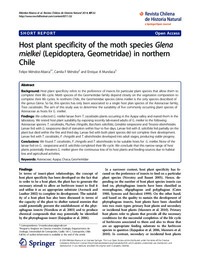Mostrar el registro sencillo de la publicación
Host plant specificity of the moth species Glena mielkei (Lepidoptera, Geometridae) in northern Chile
| dc.contributor.author | Méndez-Abarca, Felipe | |
| dc.contributor.author | Méndez, Camila F. | |
| dc.contributor.author | Mundaca-Ortega, Enrique | |
| dc.date.accessioned | 2017-11-13T12:22:00Z | |
| dc.date.available | 2017-11-13T12:22:00Z | |
| dc.date.issued | 2014 | |
| dc.identifier.uri | http://repositorio.ucm.cl/handle/ucm/1188 | |
| dc.description.abstract | Background: Host plant specificity refers to the preference of insects for particular plant species that allow them to complete their life cycle. Moth species of the Geometridae family depend closely on the vegetation composition to complete their life cycles. In northern Chile, the Geometridae species Glena mielkei is the only species described of the genus Glena. So far, this species has only been associated to a single host plan species of the Asteraceae family, Trixis cacalioides. The aim of this study was to determine the suitability of five commonly occurring plant species of Asteraceae as hosts for G. mielkei. Findings: We collected G. mielkei larvae from T. cacalioides plants occurring in the Azapa valley and reared them in the laboratory. We tested host plant suitability by exposing recently lab-reared adults of G. mielkei to the following Asteraceae species: T. cacalioides, Pluchea chingollo, Baccharis salicifolia, Grindelia tarapacana and Tessaria absinthioides. Larvae fed with G. tarapacana died of starvation within four to five days. Larvae fed with B. salicifolia fed partially on the plant but died within the first and third day. Larvae fed with both plant species did not complete their development. Larvae fed with T. cacalioides, P. chingollo and T. absinthioides developed into adult stages, producing viable progeny. Conclusions: We found T. cacalioides, P. chingollo and T. absinthioides to be suitable hosts for G. mielkei. None of the larvae fed on G. tarapacana and B. salicifolia completed their life cycle. We conclude that this narrow range of host plants potentially threatens G. mielkei given the continuous loss of its host plants and feeding sources due to habitat loss and agricultural activities. | es_CL |
| dc.language.iso | en | es_CL |
| dc.rights | Atribución-NoComercial-SinDerivadas 3.0 Chile | * |
| dc.rights.uri | http://creativecommons.org/licenses/by-nc-nd/3.0/cl/ | * |
| dc.source | Revista Chilena de Historia Natural, 87, 22 | es_CL |
| dc.subject | Asteraceae | es_CL |
| dc.subject | Azapa | es_CL |
| dc.subject | Chaca | es_CL |
| dc.subject | Geometridae | es_CL |
| dc.title | Host plant specificity of the moth species Glena mielkei (Lepidoptera, Geometridae) in northern Chile | es_CL |
| dc.type | Article | es_CL |
| dc.ucm.facultad | Facultad de Ciencias Agrarias y Forestales | es_CL |
| dc.ucm.indexacion | Scopus | es_CL |
| dc.ucm.indexacion | Isi | es_CL |
| dc.ucm.indexacion | Scielo | es_CL |
| dc.ucm.doi | dx.doi.org/10.1186/S40693-014-0022-2 | es_CL |



